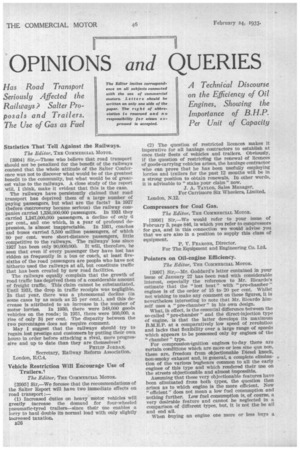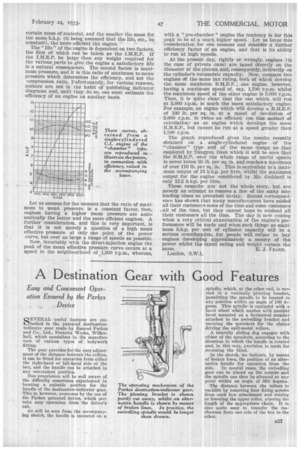OPINIONS and QUERIES
Page 40

Page 41

If you've noticed an error in this article please click here to report it so we can fix it.
Statistics That Tell Against the Railways.
The Editor, THE COMMERCIAL MOTOR.
[3994] Sir,—Those who believe that road transport should not be penalized for the benefit of the railways contend that the whole attitude of the Salter Conference was not to discover what would be of the greatest benefit to the community, but what would be of greatest value to the railways. A close study of the report will, I think, make it evident that this is the case.
The railways have persistently claimed that road transport has deprived them of a large number of paying passengers, but what are the facts? In 1921 (before controversy became serious) the railway companies carried 1,336,000,000 passengers. In 1931 they carried 1,247,000,000 passengers, a decline of only 6 per cent., and one which, in a year of profound depression, is almost inappreciable. In 1931, coaches and buses carried 5,500 million passengers, of which 90 per cent. were short-distance passengers, little competitive to the railways. The railways' loss since 1927 has been only 90,000,000. It will, therefore, be seen that even if every passenger they have lost has ridden as frequently in a bus or coach, at least fivesixths of the road passengers are people who have not hitherto used the railways at all, but constitute traffic that has been created by new road facilities.
The railways equally complain that the growth of road traffic has deprived them of a considerable amount of freight traffic. This claim cannot be substantiated. Until 1931, the drop in traffic receipts was negligible. In that year, there was a phenomenal decline (in some cases by as much as 25 per cent.), and this decrease is attributed to an increase in the number of motor lorries. In 1930, there were 348,000 goods vehicles on the roads; in 1931, there were 360,000, a rise of only 3f per cent. The disparity between the two percentages does not require comment.
May I suggest that the railways should try to regain lost prestige and customers by putting their own house in order before attacking a rival, more progressive and up to date than they are themselves?
PHILIP JORDAN, Secretary, Railway Reform Association. London, E.C.4. (2) The question of restricted licences makes it imperative for all haulage contractors to establish at once their fleets of vehicles and trailers. Obviously, if the question of restricting the renewal of licences of goods-carrying vehicles arises, the haulage contractor who can prove that he has been usefully employing lorries and trailers for the past 12 months will be in a strong position to obtain renewals. In other words, it is advisable to "stake your claim" now.
[3996] Sir,—We would refer to your issue of February 3, page 846, in which you refer to compressors for gas, and in this connection we would advise you that we are also in a position to supply this class of equipment.
[3997] Sir,—Mr. Goddard's letter contained in your Issue of January 27 has been read with considerable interest, especially the reference to Mr. Ricardo's estimate that the "lost heat" with " pre-chamber " engines is of the order of 15 to 20 per cent. Whilst not wishing to make any comment on these figures, it is nevertheless interesting to note that Mr. Ricardo himself uses a " pre-chamber " in his own design.
What, in effect, is the essential difference between the so-called " pre-chamber " and the direct-injection type of engine, is that the latter develops its maximum B.M.E.P. at a comparatively low speed of revolution and laeks that flexibility over a large range of speeds which appears to be possessed only by engines of the " chamber " type.
For compression-ignition engines to-day there are certain conditions which are more or less sine qua non, these are, freedom from objectionable Diesel knock, non-smoky exhaust and, in general, a complete elimination of the various bugbears common to all the early engines of this type and which rendered their use on the streets objectionable and almost impossible.
Assuming that these very objectionable features have been eliminated from both types, the question then arises as to which engine is the more efficient Now " efficient " does not mean a low fuel consumption and nothing further. Low fuel consumption is, of course, a very desirable feature and cannot be neglected in a comparison of different types, but, it is not the be all and end all.
When buying an engine one more or less buys a
certain mass of material, and the smaller the mass for the same b.h.p. (it being assumed that the life, etc., be constant), the more efficient the engine.
The " life " of the engine is dependent on two factors, the first of which can be taken as the I.M.E.P. If the I.M.E.P. be large then any weight required for the various parts to give the engine a satisfactory life is a natural consequence. The second factor is maximum pressure, and it is this ratio of maximum to mean pressure which determines the efficiency, and not the compression ratio. Unfortunately, for various reasons, makers are not in the habit of publishing indicator diagrams and, until they do so, one must estimate the efficiency of an engine on another basis.
Let us assume for the moment that the ratio of maximum to mean pressure is a constant factor, then, engines having a higher mean pressure are automatically the better and the more efficient engines. A further consideration, and this is very important, is that it is not merely a question of a high mean effective pressure at only one point of the power curve, but over as large a range of speeds as possible.
Now, invariably with the direct-injection engine the peak of the mean effective pressure curve occurs at a speed in the neighbourhood of 1,300 r.p.m., whereas, with a " pre-chamber " engine the tendency is for this peak to be at a much higher speed. Let us leave this consideration for one moment and consider a further efficiency factor of an engine, and that is its ability to run at high speeds.
At the present day, rightly or wrongly, engines (in the case of private cars) are taxed directly on the diameter of the pistons, and, consequently, indirectly on the cylinder's volumetric capacity. Now, compare two engines Of the same tax rating, both of which develop the same maximum B.M.E.P.; one engine, however, having a maximum speed of, say, 1,700 r.p.m. whilst the maximum speed of the other engine is 3,000 r.p.m. Then, it is quite clear that the one which will run at 3,000 r.p.m. is much the more satisfactory engine. For example, an engine which will develop a B.M.E.P. of 100 lb. per sq. in, at a speed of revolution of 3,000 r.p.m. is twice as efficient (on this method of calculation) as an engine which develops the same B.M.E.P., but cannot be run at a speed greater than 1,500 r.p.m.
The graph reproduced gives the results recently obtained on a single-cylindered engine of the " chamber " type and of the same design as that employed by Tangyes, from which it will be seen that the B.M.E.P. over the whole range of useful speeds is never below 95 lb. per sq. in. and reaches a maximum of over 110 lb. per sq. in. This is equivalent to a maximum output of 23 b.hp. per litre, whilst the maximum output for the engine considered by Mr. Goddard is only 12.2 .b.h.p. per litre.
These remarks are not the whole story, but are merely an attempt to remove a few of the many misleading ideas so prevalent to-day. Recent correspondence has shown that many manufacturers have misled all their customers some of the time and some customers all of the time, hut they cannot hope to mislead all their customers all the time. The day is now coming when a very critical examination of the engine's performance will be made and when such things as maximum b.h.p, per unit of cylinder capacity will be a serious consideration, for people will refuse to buy engines developing approximately a moiety of the power whilst the taxed rating and weight remain the
same. E. j. FEARN. London, SAVA.




























































































